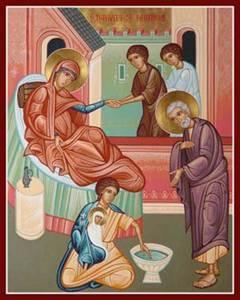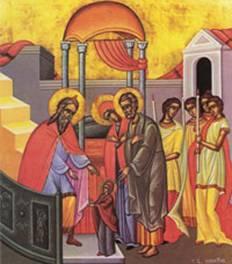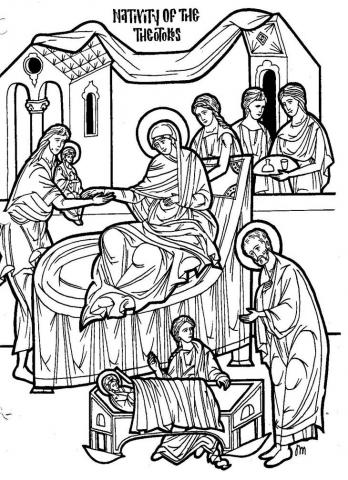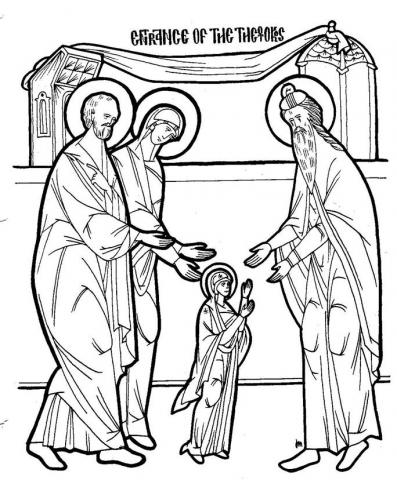Nativity of Theotokos and Presentation of Theotokos
NATIVITY OF THE THEOTOKOS AND PRESENTATION OF THE THEOTOKOS
Objectives:
- Students should be able to tell the stories of these two great feasts.
- Students should know the names of Joachim and Anna and Mary.
- Students should know the dates of the two feasts.
Possible Lesson Plan:
- Open with prayer.
2. Read the story of the feasts:
There lived in the land of Israel a couple names Joachim and Anna. Joachim and Anna were Jews; God called the Jews His chosen, or special, people, and had given them His law and His prophets. Through the prophets, God had spoken to His special people, telling them that He would send His Son to be their king. And through the years, God had given the Jewish people many mighty and godly kings, like King David and King Solomon. Joachim and Anna were from the family of David because ancestry was traced from the husband’s line. But, tradition tells us that Anna was descended from Levi, of the priestly line, and descendant of Moses. Together – a couple blessed with the heritage of the greatest of the kings of Israel and the greatest of its prophets – king and priest. Little did they know that their grandson, Jesus, would be the King of Kings, the Messiah promised by the prophets, and the highest of all the High Priests.
 Joachim and Anna were a righteous couple. But despite years of prayers, they had no children and were getting quite old, too old for children. They went to the temple constantly, praying and offering sacrifices for a child. Now, for the Jewish people, not having any children was considered a disgrace; the couple must be very wicked if God would not bless them even with a child. One day, Joachim brought yet another offering to the temple. The priest was so angry to see him yet again that he threw Joachim out of the temple. Joachim went to the hills outside the city and there prayed and fasted for forty days. An angel appeared to him and told him that they would have a baby, and this baby would be blessed by God. The angel appeared at the same to Anna at home. They ran to meet each other at the gates of the city, full of joy.
Joachim and Anna were a righteous couple. But despite years of prayers, they had no children and were getting quite old, too old for children. They went to the temple constantly, praying and offering sacrifices for a child. Now, for the Jewish people, not having any children was considered a disgrace; the couple must be very wicked if God would not bless them even with a child. One day, Joachim brought yet another offering to the temple. The priest was so angry to see him yet again that he threw Joachim out of the temple. Joachim went to the hills outside the city and there prayed and fasted for forty days. An angel appeared to him and told him that they would have a baby, and this baby would be blessed by God. The angel appeared at the same to Anna at home. They ran to meet each other at the gates of the city, full of joy.
Nine months later, the baby was born. She was given the name Mary. The righteous couple promised the Lord that this child would be dedicated to Him; this promise was later fulfilled with the presentation of Mary at the temple.
Several of the early Christian writings of Syria tell us that Mary, the Theotokos was brought to the Temple at age three to be educated, in fulfillment of a vow made by her parents, Joachim and Anna. The feast was instituted in the late 4th century.
 Mary and her parents approach the Temple in joy, accompanied by Mary’s small friends. Zachariah and the Temple virgins meet her in the Temple courtyard. The Temple is divided into three sections: the outer porch or courtyard, the Holy or nave where only Jews can come to pray and worship, and the Holy of Holies, behind a curtain, where only the high priest can enter, and he only once a year on the Day of Atonement. But, little Mary climbs directly up the steps and into the Holy of Holies, astounding all the people
Mary and her parents approach the Temple in joy, accompanied by Mary’s small friends. Zachariah and the Temple virgins meet her in the Temple courtyard. The Temple is divided into three sections: the outer porch or courtyard, the Holy or nave where only Jews can come to pray and worship, and the Holy of Holies, behind a curtain, where only the high priest can enter, and he only once a year on the Day of Atonement. But, little Mary climbs directly up the steps and into the Holy of Holies, astounding all the people
3. Read the story of the feasts: Review the story again, with the icons. Identify each figure. What was the role of each in the story? When is each feast celebrated?
- Discussion questions: Where in the Bible is this account found? (Nowhere, but in ancient Church tradition and the Apocrypha.) Why do we believe that which is not in the Bible? (It is part of the living Tradition of the Church’s memory.) Why is the feast of the Nativity of the Theotokos first in the liturgical year? What is the importance of the Theotokos? In what way, does our hope begin here? What are some other stories of women who prayed and were granted by the Lord “miraculous” babies? (Sarah, Hannah, and later, Elizabeth) In what way do Joachim and Anna fulfill Adam and Eve? How does Jacob’s ladder (Genesis 28) relate to the Theotokos? (She is the ladder who reunites heaven and earth.) Why do Mary’s parents bring her to the Temple? If they love her so much, why give her up? (Similar situation: Hannah and Samuel in I Samuel 1:9-28)
- Historical background: What was the importance of the Ark of the Covenant to the Jewish people? The Temple? Who built the first Temple? (Solomon)Why didn’t God allow David to build it? Who rebuilt the temple after the captivity? (Zerubabel) Who built the Temple that Mary entered? (Herod, who built a Temple to show the Jews how pious he was and to show the Romans the importance of his reign) When was the Temple destroyed and by whom? (the Romans in 70 AD, fulfilling the prophecies of Christ in Luke 19:43-44)
- Service References: Each is a major feast day. Read and discuss the Troparia of the feasts:
Thy Nativity, O Theotokos, hath proclaimed joy to the whole universe; for from thee did shine forth the Sun of Justice, Christ our God, annulling the curse and bestowing the blessing, abolishing death and granting us life everlasting.
Today the Virgin is the foreshadowing of the pleasure of God, and the
beginning of the preaching of the salvation of mankind. Thou hast appeared in the Temple of God openly and hast gone before, preaching Christ to all. Let us shout with one thrilling voice, saying, Rejoice, O thou who art he fulfillment of the Creator’s dispensation.
- Play a learning game – Don’t Make a Move: Write numbers from 1-10 on each of 10 popsicle sticks. Ahead of time, write 10 questions about the lesson on cards numbered from 1-10:
- Who was Mary’s mother?
- Who was Mary’s father?
- What word do we use for God-bearer?
- What is the date of the feast of the Nativity of the Theotokos?
- What is the date of the feast of the Entrance of the Theotokos?
- Where was the temple?
- How old was Mary when she went to the temple?
- What word do we use to mean “birth”?
- Where was Mary born?
(10)Who received Mary at the temple?
The first student dumps the 10 sticks in a pile. He tries to remove one without moving the others. If he succeeds, he can try to answer the question corresponding to the number on the stick. If he moves the other sticks, or cannot give the answer, the stick returns to the pile, and the next student tries. The game is finished when all the sticks are removed and all questions answered.
- Begin your time line and draw in the first two scenes. These, of course, occur “BC”.
- Close with prayer.

